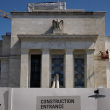by Larry Adam, Chief Investment Officer, Raymond James
Key Takeaways
- Seasonality Should Help Equities Reach ‘New Heights’
- ‘A Fine Line’ Separates Us From Another December Decline
- Positive Economic Data to ‘Upkeep’ US Expansion
Today marks the 135th anniversary of the completion of the Washington Monument. When you drive by the prominent structure on Interstate 395 in Washington DC, there is no doubt that the obelisk is an awe-inspiring reminder of George Washington’s leadership abilities and military prowess. This was exactly the goal of its designer, Robert Mills, who sought to build not only the world’s tallest building, but one free from any shadows. Completed in 1884, it serves as one of the most iconic monuments in our nation’s capital. The monument’s purpose, design, and history provide a very timely backdrop for articulating our views this week.
- Great New Heights | We’ve said before that records are meant to be broken. The Washington Monument was the tallest building in the world at ~555 feet when it was built but it has since been eclipsed by buildings more than four times its size. Since the Great Recession, we have seen the S&P 500 quadruple too, notching 25 new record highs and up 26.7% this year alone. As we enter the last month of 2019, supportive seasonality should benefit the equity market as over the last eighty years December has been positive 76% of the time and has seen an average return of 1.6%. Moving into next year, election years tend to provide support for the market as well. In the 12 months leading up to the presidential election, the S&P 500 has been positive 86% of the time and posted an average annual return of 9.0%. These trends should help the equity market continue to reach new heights.
- No Shadows Cast on US Equities | The S&P 500 is up 26.7% year-to-date, its best start to a year since 2013. While this is remarkable in its own right, it has also outperformed global equities (ex-US on a USD basis) in eight of the last ten years. Over the last decade, US equities have outpaced global equities by more than 8% annually (cumulatively more than 180%). Just as the Washington National Monument Society sought to build a structure “unparalleled in the world,” recent US equity returns have been unparalleled as well, and we maintain our bias for domestic stocks moving forward.
- A Fine Line | During its construction, several lapses in funding led to different stones with varying color and quality being used. By the time new funding was secured for the second stage of construction, the original stone from a quarry in Baltimore was no longer available, resulting in an easily visible line. This Monday’s equity decline brought fears that this December could be a repeat of last year’s sell-off. The ~9.0% decline was the worst December performance since 1938, so from a statistical perspective it was likely an outlier and not the norm. But perhaps more reassuring, there are ‘noticeable’ differences that make a repeat of last year’s meltdown unlikely. First, the Federal Reserve (Fed) raised interest rates four times heading into last December versus the three insurance cuts implemented over the last few months. The easing of financial conditions should be supportive of the equity market. Second, earnings growth is set to accelerate versus decelerate and our 2020 expectations for 5-6% growth outpaces the 1% pace seen thus far in 2019. Third, the 10-year Treasury yield rose to 3.23% in 2018, the highest level since 2011, which was a headwind for equities. Since last December, it has fallen 144 basis points, and currently 50% of S&P 500 companies have a dividend yield higher than the 10-year Treasury yield of 1.79%.
- Maintaining the Economic Expansion | Just as the Washington Monument has required routine restoration and maintenance, the US economy needs some upkeep too. The Fed has done its part, implementing three insurance rate cuts this year, and we continue to see strength and resiliency from key economic data points. The Non-Manufacturing ISM Index remained in expansion territory (a level above 50) for the 118th consecutive month, and jobless claims (203,000) neared their April levels, which was the lowest level since September of 1969. Overall, the delayed effects from the Fed’s actions combined with still positive economic data should help the US economy continue this record run.
- Peace Through Strength | As a leader George Washington was quoted as saying “to be prepared for war is one of the most effective means of preserving peace.” With the trade negotiations over the last 18 months, the Trump administration has taken a hard line approach in implementing tariffs on Chinese imported goods. With the December 15 deadline for additional tariffs approaching, our base case is that the consumer-oriented tariffs on Chinese goods will not be implemented and that some form of a truce or postponement will prevail. However, for a long term deal to be consummated, the president will have to post some ‘wins’ to show strength in the face of the upcoming election.
Read Larry Adam's full weekly views as PDF















